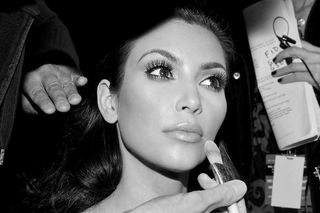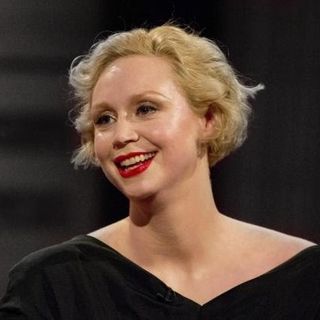
Insider Peeks at Celeb Glamor Just Raise the Bar for Beauty
Instead of exposing the effort and cost of beauty, shows like the Kardashians’ make us hustle harder to be perfect.

In recent years, a theory has held that only when we show the effort behind beauty will we break beauty norms. The illusion we keep reaching for will shatter only when we show the money, teams and time it takes to craft a perfect selfie, or a red carpet look. And people watching will know it is just not normal, not even achievable, and will stop holding themselves to the same standards. This theory is common advice to parents trying to raise savvy digital citizens, children who grow into adults and know the difference between what is real and what is not, what is achievable with what is natural.
The only problem is — it’s not working. We’ve been testing it for years in a vast social experiment called Keeping Up With The Kardashians, which has only yielded the opposite effect: the show has groomed millions of consumers intent on capturing just a fraction of the beauty manufactured in the family’s media. Instead of busting the beauty myth, the behind-the-scenes insight into the Kardashians’ and other influencers’ beauty prep has raised the bar beyond beauty — to glamor, which includes wealth, style and ambiance.
Knowing how a trick works doesn’t take away from the magic. It just makes us all think we can be magicians.
Viewers have seen the Kardashians and Jenners through cellulite lasering, facials, specialized workouts, sauna therapy, laser hair removal, lip fillers and way more than my viewing habits are able to document. We’ve seen them waking up without makeup, and we’ve seen them get ready for Met Galas.
They’re far from the only ones we’ve watched. Plenty of other influencers have also broken the fourth wall of beauty, showing behind-the-scenes photos and videos and a long list of squads to thank — for instance, videos that show stars, singers and models preparing for awards functions. In all of these photos and videos, the influencer featured takes pains to position themselves as just an average person by talking about their nervousness. But the spaces and teams in the background are anything but average. They look impossibly, well, glamorous; who doesn’t want to have 10 people working on them at the same time in some sort of magazine-cover mini-paradise or high-end hotel room? The idea of people working on you is the epitome of relaxation sold to women — from the manicurist and pedicurist to the masseuse, we’ve been taught to relax on top of the laboring bodies of other people (normally less well-off women). It harks back to the days of feudalism, when rich women had ladies-in-waiting whose sole job it was to make the former beautiful.
Even lower-budget versions of this genre of beauty entertainment speak to glamor. “Get Ready With Me,” a YouTube series by cosmetic brand Glossier, might feature less opulent surroundings, the element of glamor is still present in the people featured and the high-end products used — e.g., this installment featuring model Paloma Elesser using Giorgio Armani and Oribe products, among others. And the video’s focus on routine implies a day-to-day investment of time, money and energy into glamor. Even more insidiously, a slew of others series appears to pull back the curtain on beauty, but really just create lust for its (costly) products: the How To’s that aim to teach other women the glamor secrets of the rich and already-societally-deemed conventionally beautiful.
For the women in these videos, beauty is a requirement of their profession and/or livelihood. Stripped of all products and procedures, they effortlessly meet a baseline of societally defined attractiveness that is not impossible to find among the masses but is certainly not commonplace. They, too, feel pressure from producers, managers, casting agents and brands to live up to ever-higher beauty standards. Showing their behind-the-scenes prep might feel cathartic, or it might just be written into their contracts. Either way, they contribute to shifting the goalpost of achieving ‘beauty’ a little further, their baseline appearance being an achievement for many others.
Recently, Chrissy Teigen, known for ‘keeping it real,’ on Instagram by narrating the behind-the-scenes mad-cute of motherhood, posted a photo of herself in a sunlit, marble-floored room, lush garden visible through the floor-to-ceiling glass. She’s leaning back in a chair, legs splayed to the heavens as two people do her make-up — one for her face, one for her legs. The caption reads, “when I was young, makeup was just for the face,” a tongue-and-cheek hint at the ridiculousness society has reached in its expectations of women’s appearance — by a woman who has chosen to live up to those expectations, publicly announce it, and thus raise the bar for all others.
Related on The Swaddle:
Revisiting ‘The Beauty Myth’: What Are the Ethics of Applying Bad Facts to a Good Cause?
Knowing how a trick works doesn’t take away from the magic. It just makes us all think we can be magicians. The Cultivation Theory is a mass media concept that holds the more a person watches television, the more they define reality by what they view. It was first proposed by George Gerbner in the 1970s when television was the primary mass medium but has been extrapolated by others to the age of reality TV and social media. It seems to make sense, though it’s difficult to prove; for instance, research has suggested regular viewers of reality TV share certain traits, but it’s difficult to say whether reality TV instilled or fostered these traits, or whether reality TV just attracts viewers who already have those traits.
Most likely, it’s somewhere in the middle. Reality TV attracts a certain type of person, and then reinforces that certain type-ness. If you follow Kylie Jenner, say, because you’re amazed by her chameleon-like makeup abilities, you’re probably someone who is really into appearances and beauty (not necessarily in a shallow way!) — and the more you consume Jenner’s media, the more that interest builds, and possibly, the desire to partake of it. That latter is what funds Kylie Cosmetics, and numerous other celebrity beauty brands. That latter is also what sets a new standard of beauty and glamor. Because even as we’re being shown the work behind the illusion, we’re still seeing someone achieve the illusion.
If there’s any way out of this beauty norm one-upmanship, it doesn’t lie in showing the behind-the-scenes; we all know social media and reality TV isn’t real. Body positivity movements that strive to highlight how much more we are than our physical selves — for instance, Instagram’s @i_weigh — might help, but what we really need is to start valuing talent and productive, rather than performative, hard work at least as much as we value traditional beauty. That’s where the real magic lies.
Liesl Goecker is The Swaddle's managing editor.
Related


Small Talk: Marriage
